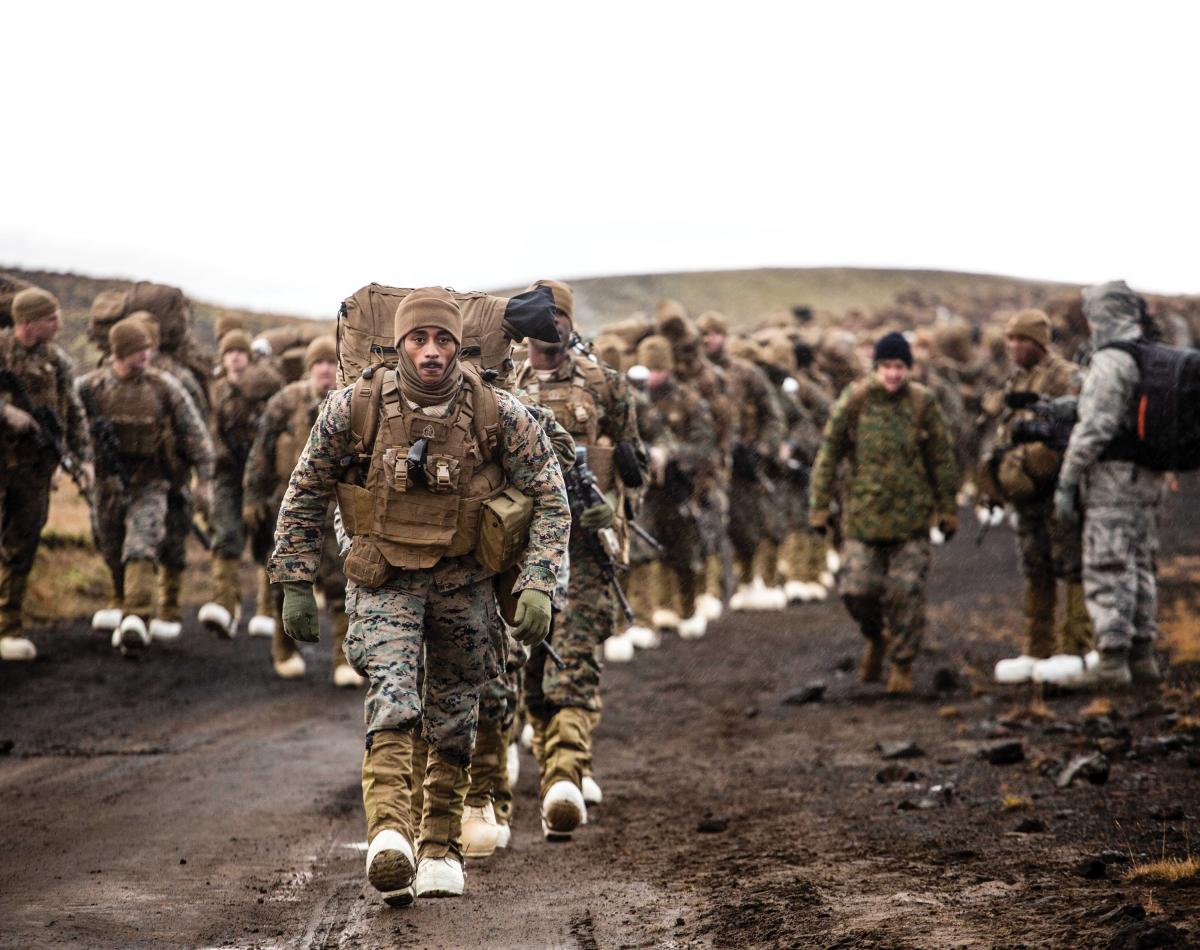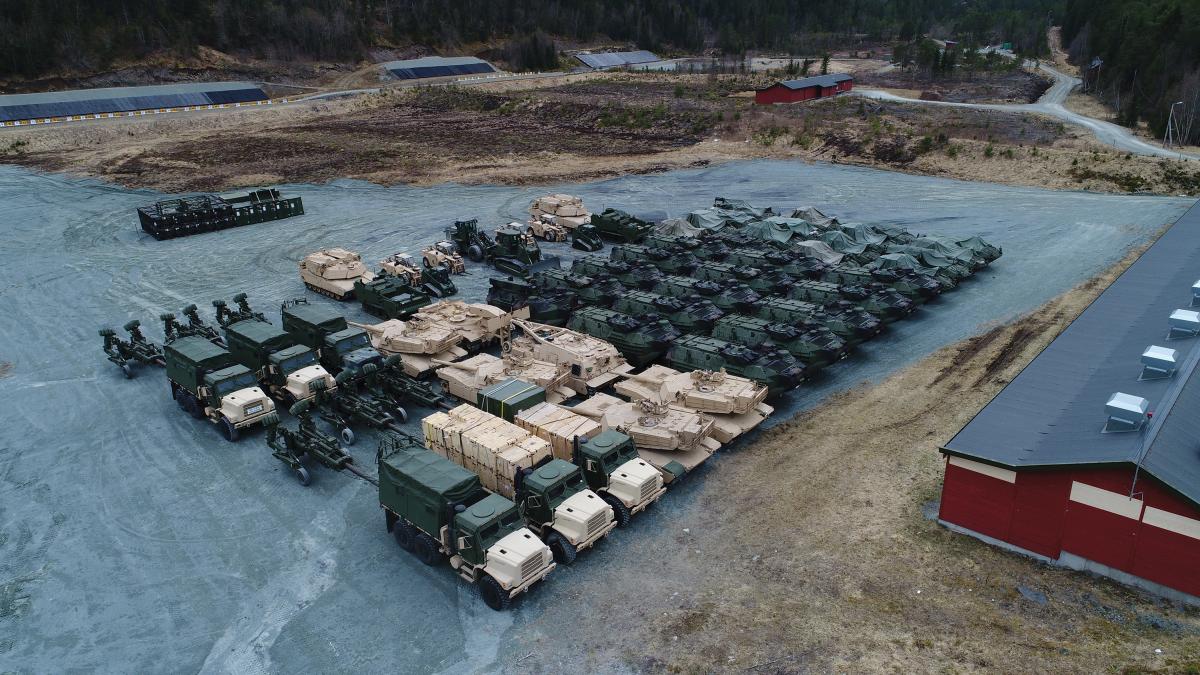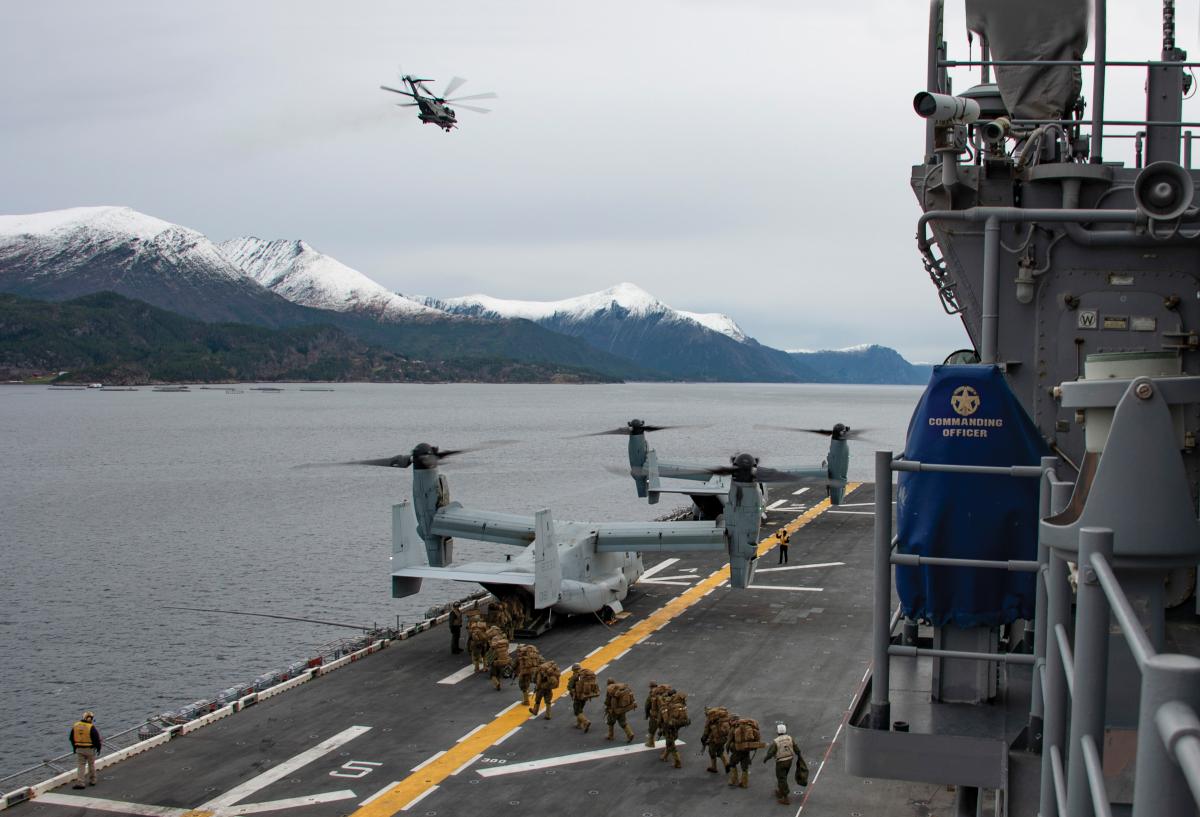In his recent address commemorating the reactivation of Second Fleet, Vice Admiral Andrew Lewis noted that in the past 20 years, the United States has become complacent about its abilities to maneuver in and project power from the North Atlantic. With the polar ice caps melting, however, countries with interests in the northern hemisphere are considering anew the North Atlantic and Arctic oceans as major operating theaters for naval and amphibious operations.1 Russia holds the most bases and ports in the high north and is continuing to build on that advantage with the widely publicized construction of new bases.2 China also is showing obvious interest in the shipping and strategic basing opportunities afforded by the north as part of its larger Belt and Road Initiative.3
In November 2018, NATO held Exercise Trident Juncture, its largest and most complex exercise in the region since the height of the Cold War. Centered in Norway, the event involved some 50,000 participants from 31 allied countries and included amphibious ships from several partner nations. The Navy and Marine Corps went to great lengths to demonstrate their operating abilities in the region, enduring cold-weather training, using pre-staged strategic logistic stores, conducting an amphibious demonstration, and integrating the Harry S. Truman carrier strike group into exercise operations.
The exercise achieved its objectives but did not go as smoothly as would be needed to respond successfully to a capable and modern belligerent. The following are lessons identified over the course of Trident Juncture. The challenge now is to learn from these lessons and advocate for the revival and evolution of our operational and strategic approach to the high north.
Past Experience
During Trident Juncture, it seemed not enough Marines had consulted doctrine or after-action reports (AAR) prior to the exercise to learn vicariously. Many of the difficulties encountered during the event mirrored issues that were identified and reported by multiple units during previous exercises, the records of which are consolidated and readily accessible in the Marine Corps Center for Lessons Learned. Some of the manuals may be 30 years old and the AARs dry, but physics and the environment of the north have not changed much since they were experienced by others.
Recently, Marine Corps Commandant General Robert Neller implored Marines to dedicate themselves to disciplined professional development, to read more, and to be constantly introspective, stating, “I don’t want to lose to learn.”4 Trident Juncture made it clear that the Marine Corps can improve in these areas, and it starts with the individual Marine.
International Law
With today’s antiaccess, area denial threat, ample maneuver space for the amphibious operations of the Navy, Marine Corps, and NATO partners is more important than ever. The ice that previously limited transit is receding, and the passages connecting North America and Eurasia are expected to become contested for their key strategic and economic benefits.
Russia, in particular, sees this terrain as important, backing up its words with deployments of motorized rifle brigades in northern Siberia, stationing fighter-bomber aircraft in the area, establishing quick-reaction marine and airborne units, and basing its nuclear-armed Northern Fleet on the Kola Peninsula.5 The Russian Federation has extended its exclusive economic zone claims and sought a higher degree of state control over the extended continental shelf it considers part of its landmass in the north. Leaving this assertion unchallenged, the United States and its allies essentially are ceding the legal initiative, potentially hampering NATO’s future ability to use that space for deterrence and crisis response.
Although it is unlikely Russia would abide by a resolution reached by an international majority, the global community must craft a sound legal framework that eliminates the gray space in which Russia thrives and defines the black-and-white guidelines that an organization such as NATO needs to respond to acts of aggression. Unfortunately, while the greater international community is mired in disagreement or apathy, Russia has solidified its control of the northern littorals. NATO nations are likely to regret their inaction should they fail to address the issue soon.
Operational Logistics
Under the Marine Corps Prepositioning Program–Norway (MCPP-N), the Norwegian government provides protection and means to load, transport, and store a sizable amount of Marine Corps vehicles and equipment, as well as general logistic support to deploying troops.6 Augmenting MCPP-N is the Maritime Prepositioning Force (MPF), which augments land-based stores and aids in flexible and rapid force buildup. Both these capabilities were exercised and their value proven at Trident Juncture. However, many units arrived in country expecting that the full complement of stored assets would be available only to find that a significant number were nonoperational as a result of long-term storage issues and limited on-hand spare parts.
In addition, an MPF ship is largely limited to pierside offload because, realistically, for sea-based operations it requires a sea state of 1 or less, a weather condition nearly nonexistent in the North Atlantic. While these realities have been experienced by many units exercising an MCPP-N or MPF gear set, unit staffs are consistently surprised when they discover they are limited to a few ports, not all the gear is road-worthy, or that far more class IX repair parts are required than they anticipated.
Tactically, amphibious forces must expect and plan to operate with less than what is advertised in prepositioned equipment. Operationally, there are not many options for ship-to-shore movement in the Nordic littorals, and sea ports of debarkation are limited, presenting constraints on concepts of operation. The answer may be to rely heavily on NATO partner logistics supplies during the amphibious operation to secure a foothold while the U.S. logistics machine works to deposit its “iron mountain.” Strategically, the Navy and Marine Corps team have work to do to evolve sea-based logistics in the constrained maneuver spaces of the North Atlantic.
Shoot, Move, Communicate
Trident Juncture demonstrated that in the far north, moving and communicating are significant challenges for the vehicles and equipment currently in the Marine Corps’ inventory. NATO’s crisis-response function requires rapid movement over host-nation infrastructure, including in the mountainous and forested terrain of Scandinavia and the Baltics. But not all rail stations or cars can accommodate some of the heavier vehicles employed by various NATO partners. In addition, tire chains and studded tracks are required for various types of armor, vehicles, trailers, and howitzers to operate in the Arctic, but some of these often are not readily available in Marine Corps stockage.
Issued equipment also can pose a challenge for light infantry mobility. During another recent cold-weather exercise, a significant number of ski bindings failed under combat conditions, as did the plastic frame of the main pack when subjected to a normal combat load in the extreme cold. Issued warming layers are made of fire-retardant synthetic materials that lose their warming properties when dampened by sweat and the moisture common in the Norwegian highlands. Finally, the large, thick, extreme cold-weather boots are heavy and lack the necessary traction to be of much use on patrols over challenging terrain. These issues are not unfamiliar, yet the Marine Corps is still in the early stages of finding an answer and remains ill prepared for a cold-weather conflict.7
In contrast, partner nations from northern regions use vehicles designed or augmented with the right gear so as to be useful in every season, including extreme cold. Similarly, to withstand the rigors of combat in the elements, their personal gear is designed with metal in place of plastic, wool in place of cheaper synthetics, and over-boot solutions that enable versatile foot mobility. These lessons must be built into multipurpose programs of record that will set conditions for success in a cold-weather conflict. Until then, current equipment stock presents a self-inflicted obstacle.
Communication in the far north has long been known to present challenges. The 1988 Cold Weather Handbook for Surface Ships cites multiple considerations for arctic communication, including controlling ice on antennae, the effects of sleet and snow on electromagnetic transmissions, narrow takeoff angles to satellites in geosynchronous orbit, and erratic charging of the ionosphere near the poles that causes inexplicable and sudden satellite, HF, and radar degradation or outages. Nothing is new under the sun, yet almost every standard practice in tactical communications was found wanting during this exercise.
Command and control occurred during Trident Juncture, but reliance on voice and data over satellite and HF transmission assets was questioned. Aside from the physics of the environment, working with NATO partners always induces friction as partner-nation communicators must integrate divergent equipment and technology, all of which is governed by multiple bureaucracies. The Marines overcame these challenges by augmenting partner units with communicators, equipment, and staff liaisons, which ensured that transmissions were received no matter the sending medium or encryption type. In the end, the loss of some end-strength is worth smooth command and control. Yet even when everything is planned and executed to perfection, space- and skywave-based transmissions do not always behave in predictable ways, and the operational levels of command at Trident Juncture felt that reality acutely.
In contrast, the Norwegian military relied heavily on ground-wave radio for voice and data transmission, in some cases through repeaters strung for miles over all kinds of terrain. This has the obvious benefit of ignoring atmospheric weather and angles, while also reducing skyward omnidirectional signals that kinetic and nonkinetic fires can easily target. While groundwaves also can be targeted, they do not immediately indicate the location of a major command node the way centralized space-oriented electromagnetic emanation does.
Host-nation commercial infrastructure also is used extensively by U.S. partners, making them flexible and hard to target because they can plug in and communicate virtually anywhere cellular and commercial internet connections exist. Unfortunately, the Marine Corps has not fully embraced the modern encryption and system engineering that could enable Marines to augment tactical systems with commercial service providers, regardless of their ownership, without fear of losing transmission integrity or confidentiality. One way to address this is by engineering a standardized, fleet-wide system of encryption and security devices in a small form factor capable of using any cellular or internet connection for secure communication. This would enable advance parties, dispersed detachments, and jump command posts to travel lighter, communicate more flexibly, and generate a smaller signature, all while practicing advanced security standards that ensure transmission security. This capability exists today, but the equipment is fielded to a limited set of units and is in serious need of modernization.
Information Operations
In the age of hybrid warfare, information operations (IO) have risen in the hierarchy of needs, particularly in the never-ending phase 0 in which the global security environment forces us to engage. Recognizing this, the Marine Corps made significant changes to its force structure in the past year, combining the public affairs and combat camera specialties into communications strategy and establishing a new cyber warfare field. It also established the Marine Expeditionary Force Information Group, which is designed to integrate and operationalize these and all other aspects of IO. During Trident Juncture, these sources of strength proved invaluable, both conceptually and in real time, demonstrating their utility in what would certainly be a highly contested information environment should Article 5 be invoked against a state such as Russia.
These capabilities, covered by counterintelligence Marines, enabled the objectives of Trident Juncture to be met while denying attempts to malign and passively oppose NATO’s efforts. Unfortunately, the United States in general seems to be lagging in the field of IO. China’s Belt and Road Initiative dominates international news, but its spending on foreign direct investment in ten prioritized countries is approximately a third that of the United States.8 Political and defense institutions seem to be admiring the problem with few public solutions.9 The answer may simply be to do a better job at externally oriented IO, reminding the world of the good the United States has done and is doing. On the defensive side, Estonia and Ukraine provide excellent examples of debunking Russian IO on a national scale, inoculating much of their populations to the noise. This is something the U.S. military and media ought to develop and expand.
Set the Conditions for Success
Though the far north at present does not offer enough military or economic benefits to make armed conflict worthwhile, peer competitors are demonstrating by their actions that they believe this will change in coming years. NATO and its friends are lagging these pacing threats and lack the key policies required to gain stability and advantage in the Arctic. Further, many of those partners not residing in the north, including the United States, currently lack instruments of military power optimized for operations in that environment. Most important, the West is losing the information war, setting conditions for the defeat of its priorities. Warfighting professionals need to consider these strategic implications and become students of the past as they build readiness to deploy and win in every domain of this theater.
1. Secretary of the Navy Richard Spencer, Center for Strategic and International Studies, 6 December 2018, https://csis-prod.s3.amazonaws.com/s3fs-public/publication/181206_ConversationwithHonRichardVSpencerSecretaryoftheNavy.pdf.
2. ADM Harry B. Harris, USN, Statement before Senate Armed Services Committee, 15 March 2018, www.armed-services.senate.gov/imo/media/doc/Harris_03-15-18.pdf; and GEN Curtis B. Scaparrotti, USA, Statement before Senate Armed Services Committee, 8 March 2018, www.armed-services.senate.gov/imo/media/doc/Scaparrotti_03-08-18.pdf.
3. John Simpson, BBC News, 18 December 2018, www.bbc.com/news/world-europe-46386867.
4. COL Christopher Woodbridge, USMC (Ret.), “Learning without Losing,” Marine Corps Gazette, November 2017.
5. Kiel Conference on the High North, Center of Excellence for Operations in Confined and Shallow Waters 2016, www.coecsw.org/fileadmin/coe-csw/images/news/2016/KiCo/Kiel_Conference_2016.pdf.
6. Memorandum of Understanding Governing Prestockage and Reinforcement of Norway, Department of Defense, 2005.
7. Shawn Snow, “When Hell Freezes Over: How the Corps Plans to Win in a Cold Weather Fight in Russia or North Korea,” Marine Corps Times, 20 February 2018.
8. Abigail Grace and Daniel Kliman, “Power Play: Addressing China’s Belt and Road Strategy,” Center for a New American Security, September 2018, www.cnas.org/publications/reports/power-play.
9. Jane Lanhee Lee, “U.S. Should Create Fund to Counter China’s Belt and Road Push,” Reuters, 14 November 2018, www.reuters.com/article/us-usa-china-roads/u-s-should-create-fund-to-counter-chinas-belt-and-road-push-commission-idUSKCN1NJ0E1; and Hunter Marston, “The U.S. Needs a Reality Check on China’s Belt and Road,” The Diplomat, 31 May 2018, https://thediplomat.com/2018/05/the-us-needs-a-reality-check-on-chinas-belt-and-road/.





